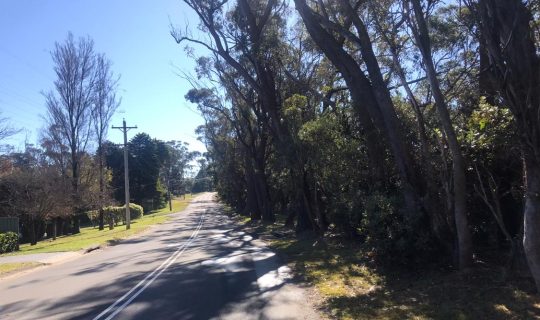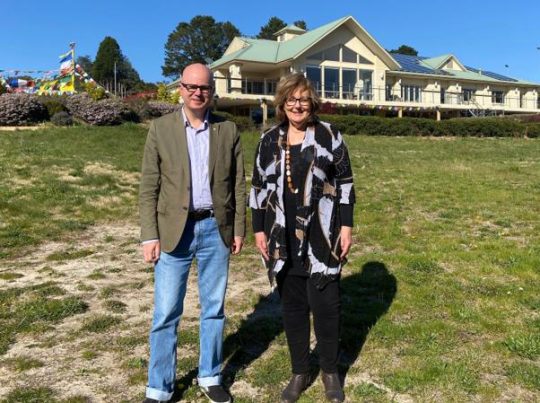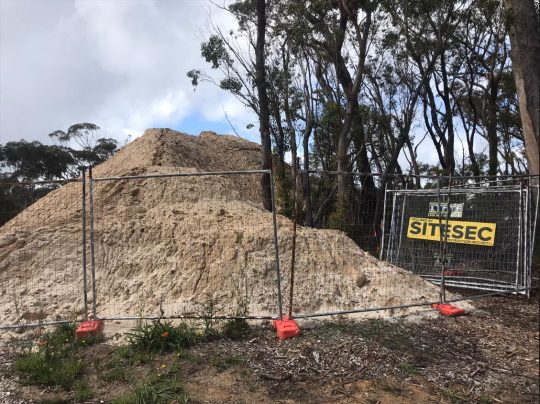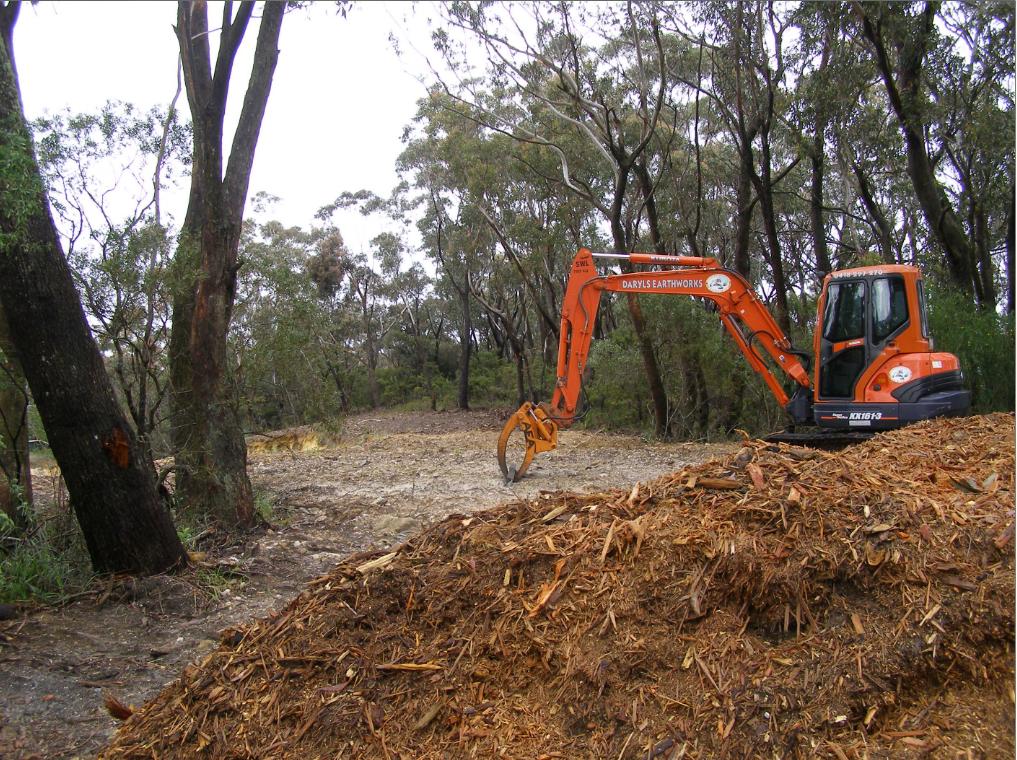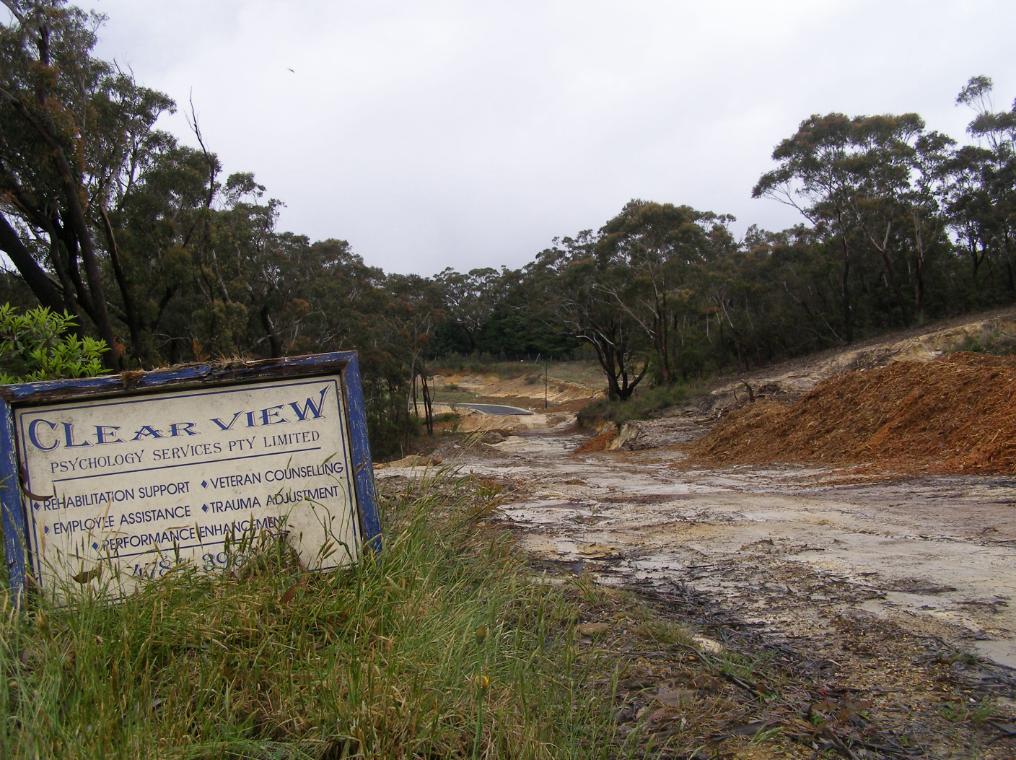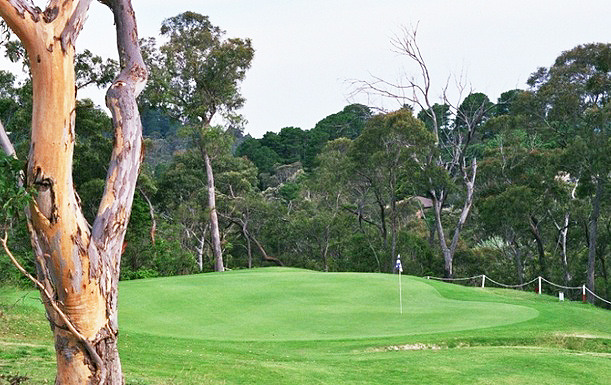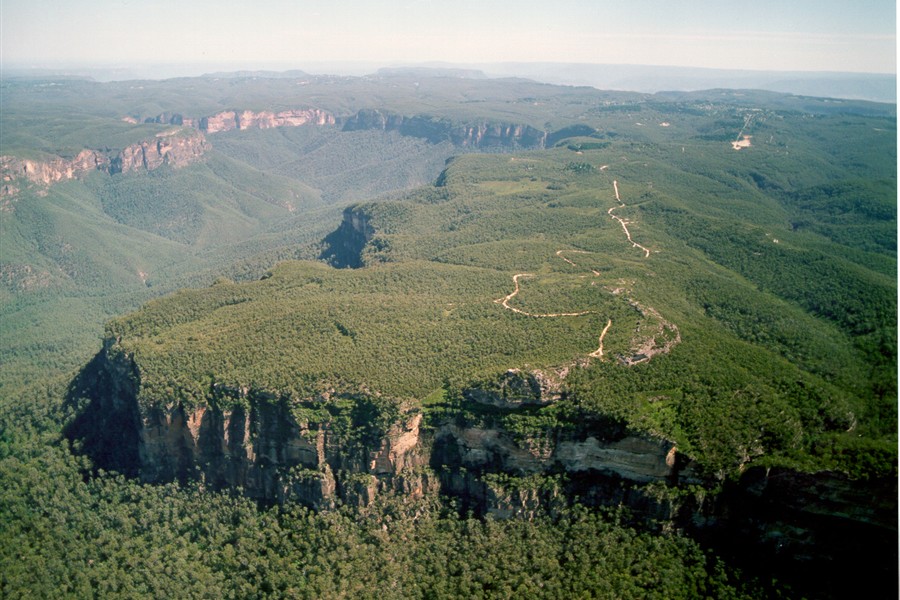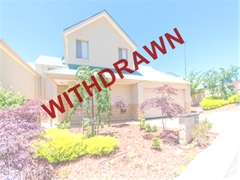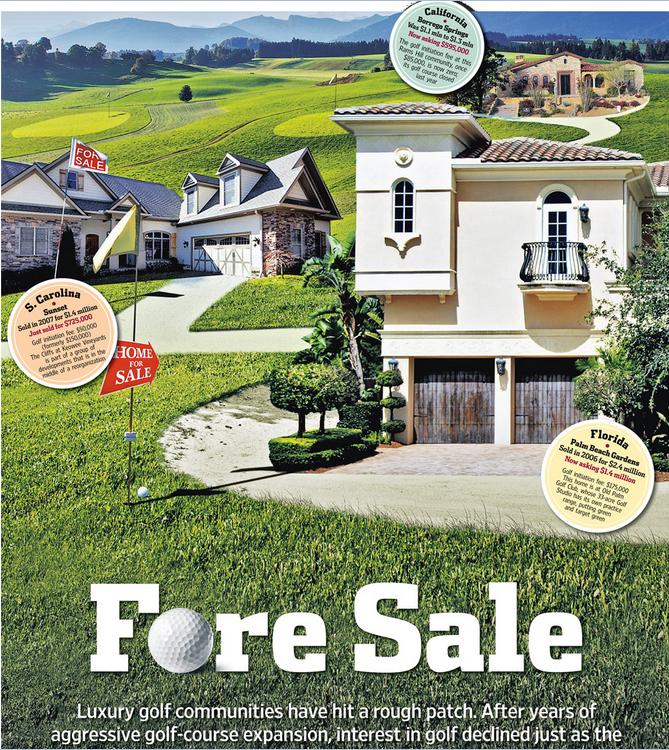Council’s ‘planetary health’ is a misnomer
Sunday, June 2nd, 2024Blue Mountains {city} Council’s latest greenwashing promotion of itself, it terms its ‘Planetary Health Initiative‘.
But what on Earth is this construct syntax ‘planetary health‘?
Some quick online research reveals it’s all about human health, not that of planet Earth. It is another anthropocentric ideology, so those guilty of damaging native habitat can feel warm and fuzzy by token eco-gesturing.
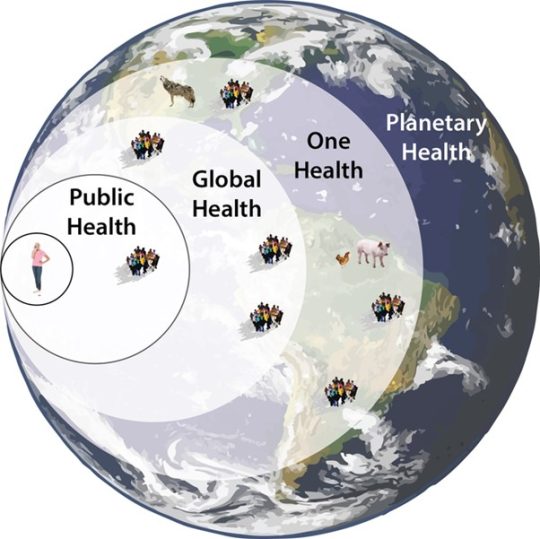
We found on a quick Internet search, this cone-shaped model image of how individual human health is the pinnacle and ‘Planetary Health’ being the fifth tier below? It’s globalist and anthropocentric, that is centred on humans above all else. So humans first and other species and Ecology may then benefit?
The Habitat Advocate disagrees strongly with any anthropocentric philosophies. In stark contrast and transparently, we advocate the ‘Deep Ecology‘ philosophy – meaning:
“Deep ecology, environmental philosophy and social movement based in the belief that humans must radically change their relationship to Nature from one that values nature solely for its usefulness to human beings to one that recognizes that Nature has an inherent value.”
This is a recommended read: ^https://www.britannica.com/topic/deep-ecology
In our view, ‘Planetary Health’ comes under the realm of ‘Greenwashing‘ – typically a public relations ploy used by both governments and corporations that are way short of best practice to protect the natural environment under their custodial stewardship, so they resort to token public relations campaigns using expert consultants and publicly trusted ‘celebrities’ to message ‘ecological care’ when it isn’t. Blue Mountains {city} Council is a serial offender of greenwashing – we think the worst in Australia given the council’s location (surrounded by and upstream of natural World Heritage), its record of environmental neglect and harm, and its hubris about is continual self back-patting claims of its ecological stewardship.
Greenwashing?
“‘Greenwashing’ is a term used to describe false or misleading environmental claims. Greenwashing makes business appear more environmentally beneficial than they really are. Omitting information can amount to a false or misleading representation or misleading or deceptive conduct, depending upon the circumstances and the overall impression created. We consider a business to be engaging in greenwashing where they use any claim that makes a product or service seem better or less harmful for the environment than it really is. Sometimes businesses accidentally mislead consumers. By following the ACCC’s guidance, businesses that make environment or sustainability claims are less likely to mislead consumers and break the law.”
[SOURCE: ‘Greenwashing defined’, Australian Competition and Consumer Commission, ^https://www.accc.gov.au/business/advertising-and-promotions/environmental-and-sustainability-claims]
A reality check:
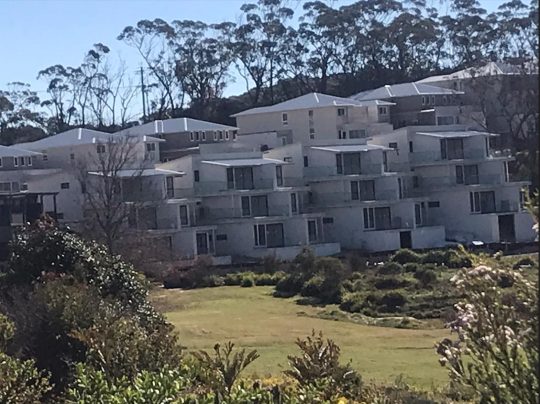
Planetary health? Not for the planet, yet this is what Blue Mountains {city} Council approved – ugly mass over-development for many more humans on old Katoomba Golf Course into what was bushland within The Gully Catchment.
Where is this current high density townhouse development taking place?
It’s more than 3 km from Katoomba’s retail precinct, isolated on the defunct golf course site (was fairway #3) within just 100 meters of the World Heritage Jamison Valley escarpment across Narrowneck Road. Here’s the location map with the black star showing the site location of the above photo image.
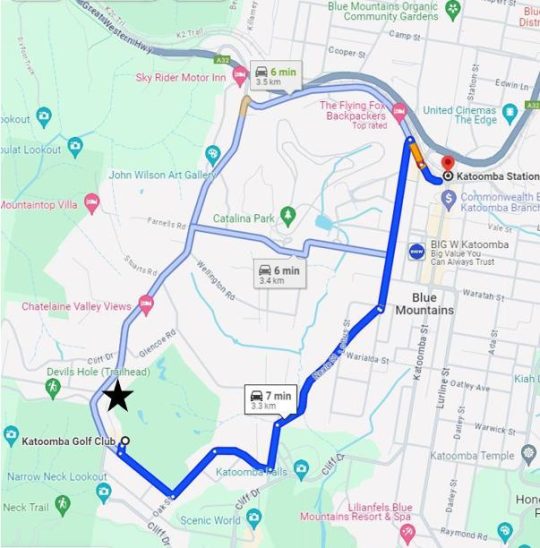
The black star is the location of this current massive over-development’ of 24 additional townhouses. Transport access is only by private car. It’s isolated just like the ‘The Escarpments’ totalling 21 townhouses adjoining. [SOURCE: Google Maps plan view, 2024 with the black star superimposed]
In our view, hardly close to amenities, and these properties aren’t cheap…
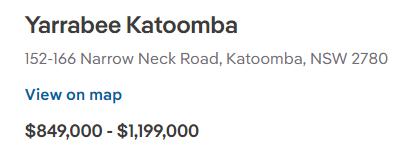
Source: ^https://www.realestate.com.au/project/yarrabee-katoomba-600040364 , accessed 2024-06-01]
The defunct Katoomba Golf Course Clubhouse?
At Council’s public meeting of 29th September 2020, councillors endorsed purchase of the defunct Katoomba Golf Course Clubhouse site (1 Acacia Street, Katoomba) for $3.3 million using ratepayers’ money of course, not theirs. So, an easy low-risk decision by said councillors who voted ‘YES’.
That old defunct clubhouse sits alongside the similarly defunct Katoomba 18-hole golf course – long owned by council. This combined site has become council’s largest operational land holding, at 29.66 hectares (so pretty much 30 hectares). It’s bigger than Ben Hur. It exceeds Council budget and Council doesn’t know what to do with it.
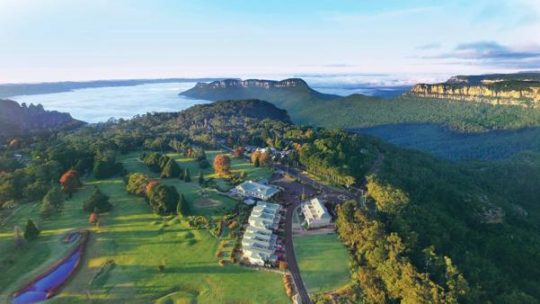
An old PR aerial photo of the defunct Katoomba Golf Course and Clubhouse pre-2013. Plus note the separate portion of designated golf course land that Council subdivided, re-zoned ‘Operation’ and flogged off for profit to a townhouse developer [the housing row deliberately centre focus of the photo].
A key Blue Mountains community question here is that given the Katoomba Golf Club and its predominant owner at the time, golfer Geoff Reed of Reed Constructions had in 2012 gone into liquidation, and the Club then followed suit being liquidated in 2013; so to whom did Council pay the $3.3 million out of Blue Mountains ratepayers’ funds?
Presumably, the money was paid to the Katoomba Golf Club’s liquidator so as to pay off the Club’s owed creditors and owed staff salary entitlements. This means that local ratepayers ultimately bailed out this failed golf club, not Council. This sham had all the while for well over a decade, seen Council senior management and ratepayer-elected councillors stage numerous closed-door secret meetings at Council chambers with the Club and developers (denying access to ratepayers) – yet those developers ultimately all went bloody broke, and ratepayers took the can.
All the while for decades, fewer were interested in playing golf. The writing had been on the wall for decades.

[Source: ‘Is Economy Or Lack Of Interest Hurting Golf?’, 2011-05-23, by Ian Hutchinson , ^http://www.golfnewsnow.ca/2011/05/23/is-economy-or-lack-of-interest-hurting-golf/]
Quite separately, a third adjoining site to the direct east of the Clubhouse used to also be part of the community land that Council undertook in 1920 to be for explicit sole use for the old Katoomba Golf Club. But multiple dodgy closed door meetings by Council re-zoned numerous fairways into ‘operational land’ (so deeming the land saleable) so that Council could flog them off for profiteering of community land to a developer for dense housing development, which it did during in the 1990’s for its own coffers.
That’s just a brief background to this multi-decade saga.
- So why did Council buy it?
- What was the hard sell to councillors who voted to approve the purchase?
- Who benefits?
- What is the return on investment for Blue Mountains ratepayers?
- How is this part of Council’s remit?
- Surely there were opportunity costs for a lazy $3.3 million – like potholes fixed, rates reduced, landslips properly repaired and vital access roads re-opened?
- Did this $3.3 million purchase of a tired building (hardly an “asset”) ever appear on Council’s strategy plans, like on its 2017 ‘Blue Mountains Community Strategic Plan 2035’?
Council since its 2020 purchase of the Clubhouse, has for the past four years been trumpeting its planned re-purposing of this 30 hectare defunct recreational site, including options for re-use of the old clubhouse. Before, that purchase and before any local community consultation. Council’s consultation with the local community didn’t start until 14th March 2022.

“You’re invited to imagine the future of the former Katoomba Golf Course Precinct” [SOURCE: ^https://yoursay.bmcc.nsw.gov.au/katoomba-golfcourse-precinct-plan (Yeah but Council has since made this page private – ratepayer funds at work).
Council at least two years prior had already (secretly again) seconded external consultants for ideas about the site’s possible uses (another Greenwashing public relations campaign to justify Council’s $3.3 million expense of ratepayer’s funds and its proposed ‘noble’ initiative).
Yet, The Habitat Advocate previously accessed Council’s webpage. We also made a written submission which we shall soon share publicly in a subsequent article on this website.
We discovered the following fine print, which reveals Council had already pre-decided that any community ideas would have to conform within its notion of restoring planetary health – whatever Council decided to have that mean…
Quote:
“Former Katoomba Golf Course Precinct Plan
You’re invited to imagine the future of the former Katoomba Golf Course Precinct
At this extraordinary time, at an extraordinary site in our City within a World Heritage Area, we have an amazing opportunity to do something special.
We urgently need to take better care of nature to protect our own health. Our City is perfectly positioned to explore ways to care for our planet’s natural systems and share these solutions globally.
With Traditional Custodians, our community, educators and researchers from a number of universities, Blue Mountains City Council is exploring opportunities related to planetary health initiatives at the former Katoomba Golf Course precinct (clubhouse and adjoining 30 hectares of public land). We are doing this for the long-term benefit of our City and our community and to create new job opportunities.
We want to know – what opportunities you see for the former Katoomba Golf Course site? How do you think this site could be transformed to help restore planetary health?”
That is why in Council’s media release about the purchase, Council was already on the front foot flagging its pre-arranged re-purposing plans for the large site under its newly conceived ‘Blue Mountains Planetary Health Initiative‘. Read the two media releases we reproduce below – one by Council dated 5th October 2020, the other by Western Sydney University dated 10th December 2020. Recall councillors approved the purchase of the clubhouse on Tuesday 29th September 2020, just a week before Council’s media release, as stated in this article.
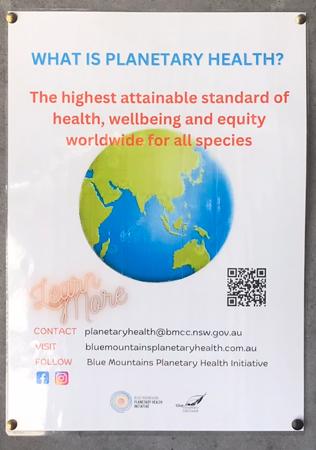
Council’s promotional poster inside its Planetary Health Centre. “The highest attainable standard of health , wellbeing and equity worldwide for all species”. [Photo by Editor 2024-05-26]
A few fact checks here…
The same verge 50 metres south along Narrowneck Road…
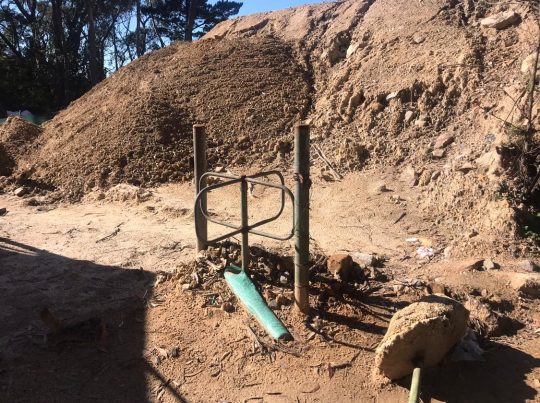
Ye olde turnstiles that provided public access to the Katoomba Golf Course through what had been a fence behind the bushland verge. [Photo by Editor 2024-05-26]
And the forthcoming beneficiaries of Council’s so-called planetary health initiative? …
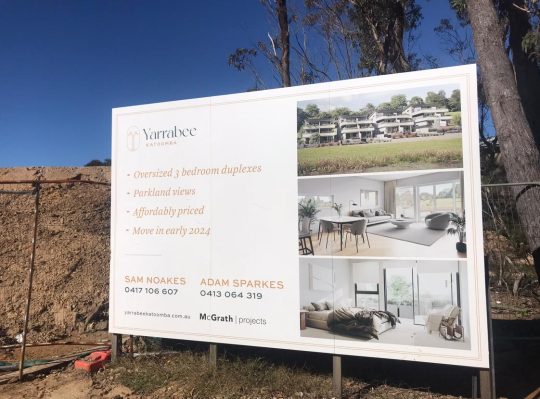
BENEFICIARIES: Council’s coffers for selling off what was Community bushland, soon the Developer’s coffers with commission to McGrath real estate agent’s coffers. Oh, and ‘Yarrabee’ means ‘place of many gums‘ in Aboriginal. We’ll, there used to be. [Photo by Editor 2024-05-26]
Council has set up a webpage that defines its understanding of this rather academic globalist concept of ‘Planetary Health‘, stating: “Its aim is to provide a framework for us to reassess and adapt human practices to better support a healthy planet for current and future generations.”
Council webpage on this rattles on… GoTo: ^https://www.bmcc.nsw.gov.au/what-planetary-health
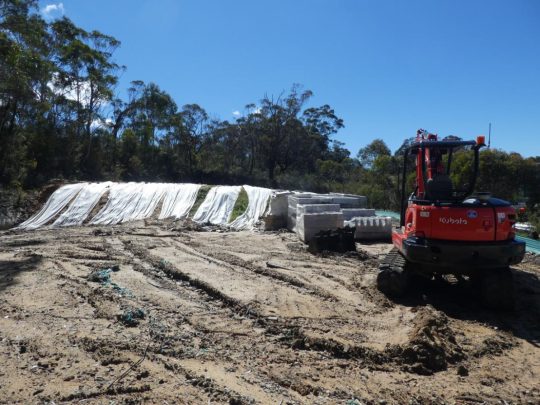
Council: …”adapting human practices to better support a healthy planet “…on Council’s defunct Katoomba Golf Course site (this was the 3rd hole). This location is just 300 metres from Lis Bastian’s Planetary Health Centre on the lower ground floor of the old clubhouse. [Photo by Editor 2021-04-11]
Council’s initiative programme is being delegated to Blue Mountains local Lis Bastian, now Council’s Senior Programme Lead for the Planetary Health Local Action Programme. Now there’s a bureaucratic mouthful. Ms Bastian is an experienced art teacher, grassroots environmentalists of sorts with a passion for The Arts and Permaculture amongst other interests and public leadership roles. An eco-celebrity being used by Council to garner trust with the local community. A brave person to take on this role.
But Council didn’t initiate this “Planetary Health” nonsense.
Prior to Council effectively buying back a building asset on the community land of Katoomba Falls Creek Valley it had long already owned, Council had consulted with Western Sydney University to try to attract university interest and ongoing funding for this otherwise very large defunct recreational site on the edge of Katoomba.
This is the Western Sydney University’s media release timed around the same time of Council’s purchase of the Golf Clubhouse (actually, less than two weeks later from 29th September 2020, thus:
‘Western Sydney University to explore Planetary Health excellence in local area’
2020-12-10, by Emma Sandham, Senior Media Office, Western Sydney University, ^SOURCE
“Western Sydney University has signed a Memorandum of Understanding (MOU) with Blue Mountains City Council (BMCC) and the Monash Sustainable Development Institute to explore the establishment of a Planetary Health Leadership Centre in Katoomba.
The Centre – to focus on the emerging science of Planetary Health, which links our activities with the health of people and the planet – is set to be based at the former Katoomba Golf Clubhouse recently purchased by BMCC.
Western Sydney University’s Deputy Vice-Chancellor and Vice President (Research, Enterprise and International) Professor Deborah Sweeney commended the signing, which will place Western at the forefront of this emerging interdisciplinary research field.
“This MOU underpins the University’s mission of striving for innovation and excellence in its pursuit of impactful research that solves some of our most pressing local, regional, national and international challenges,” said Professor Sweeney.
The Planetary Health Leadership Centre’s (PHLC) proposed aims include:
- The research and promotion of sustainable living, environmental science and other initiatives relating to how human practices can better support a healthy planet for current and future generations;
- Research into climate change and bushfire management, and their impact on the Blue Mountains World Heritage Area and its unique biodiversity;
- A reinvigorated sustainability model for the region based on the principles of planetary health;
- A substantive forum for BMCC, academics, local stakeholders, and global theorists and practitioners to be in meaningful dialogue about:
- the practicalities of enacting transitions to cultures of planetary health;
- the undertaking of research and promoting the development of strategies to improve the environmental health of the planet and to respond to the challenges of climate change, natural disaster, bushfire, and other processes which threaten sustainable living;
- emulating the persona of the Blue Mountains as a unique place that fosters a culture of diverse and high quality creative endeavour as a City of the Arts.
Blue Mountains Mayor Mark Greenhill said: “The signing of this MOU to coincide with the 20th anniversary of the Blue Mountain’s World Heritage status announcement, is fitting.
Planetary Health is a global imperative. It resonates with the people of the Blue Mountains, but it is a matter for all people globally.”
For further information about plans for the PHLC, please contact Professor Nicky Morrison nicky.morrison@westernsydney.edu.au.
Yet, before 2020, we find this online academic article on Planetary Health dated September 2018…
‘Planetary Health: From the Wellspring of Holistic Medicine to Personal and Public Health Imperative’
by Susan L Prescott 1, and Alan C Logan 2, PMID: 30316687 DOI: 10.1016/j.explore.2018.09.002, National Library of Medicine (an official website of the United States government), ^SOURCE.
Abstract
“The term planetary health – denoting the interconnections between the health of person and place at all scales – emerged from the environmental and holistic health movements of the 1970-80s; in 1980, Friends of the Earth expanded the World Health Organization definition of health, stating: “health is a state of complete physical, mental, social and ecological well-being and not merely the absence of disease – personal health involves planetary health”.
By the 1990s, the concept of planetary health was part of the fabric of integrative medicine; more recently, after the 2015 Lancet Commission on Planetary Health report, the concept has penetrated mainstream academic and medical discourse.
Here, we explore this history and describe its relevance to contemporary healthcare; integrative medicine is uniquely positioned to educate and advocate on behalf of patients and communities (current and future generations), helping to safeguard health of person, place and planet.
We use the emerging microbiome science as a way to illustrate the interconnectivity and health implications of ecosystems (including social/political/economic systems) at all scales. As highlighted in the Canmore Declaration, mainstream planetary health discourse will be strengthened by inter-professional healthcare perspectives, and a more sophisticated understanding of the ways in which social dominance orientation and medical authoritarianism compromise the World Health Organization’s broad vision of global health.
Planetary health isn’t a “new discipline”; it is merely an extension of a concept that was understood by our ancestors, and remains the vocation of all healthcare providers. Discourse on the topic requires cultural competency, critical consciousness and a greater appreciation of marginalized voices.”
Ok, so this term ‘Planetary Health’ pre-existed as a human holistic health concept back in the 1960’s. So, it was definitely NOT Blue Mountains {city} Council’s original initiative. Yet, admittedly borrowed from some external consultant – a university or one more local?
Notably, the term ‘planetary health‘ from this definition from 2018 is clearly NOT about the health of the planet, but rather the health of person and place. The notion is purely anthropocentric – meaning “regarding humankind as the central or most important element of existence, especially as opposed to God or animals“. [Oxford Dictionary]
It states that by the 1990s, the concept of planetary health was part of the fabric of integrative medicine. So NOT ecology.
Council has made up it’s own different definition, akin to somehow saving the planet. But clearly not by what it does itself, but by what it expects others to do.
Out of the blue then in 2020, Blue Mountains {city} Council issued a press release to the local Blue Mountains Gazette newspaper
‘University push for Katoomba as council buys old golf clubhouse site’
“Two universities are planning to establish a centre in Katoomba under a major proposal unveiled by Blue Mountains City Council. Monash University and Western Sydney University are currently finalising a Memorandum of Understanding (MoU) with council after it purchased the old Katoomba Golf Clubhouse site for about $3.3 million. The MoU sets out a commitment to establish a leadership centre of international significance in the field of planetary health at the clubhouse site.
Monash University’s Sustainable Development Institute director, Professor Tony Capon, described the plan as “a visionary way to mark the 20th anniversary of the UNESCO world heritage listing of the Greater Blue Mountains Area next month. We are very much looking forward to pressing forward with our shared vision for planetary health in the Blue Mountains,” he said.
Councillors endorsed the purchase of the clubhouse site that sits alongside the former Katoomba golf course – already owned by council – at their September 29 meeting. The purchase makes the site council’s largest operational land holding, at 29.66 hectares.
Blue Mountains Mayor Mark Greenhill: “The site is a strategic investment opportunity with significant potential benefits for the city in the short, medium and long term,”
“Council will explore, with the community, the best strategic options for future uses of the precinct through the upcoming master plan process for Katoomba. What’s exciting is that this opportunity gives us our first real chance to work with universities to establish a leadership centre in the Blue Mountains that would provide jobs, as well as income that comes from sources other than rates.”Establishing a planetary health leadership centre with universities was part of a local strategic planning statement endorsed by council this March.
Discussions with the universities have canvassed linking the centre with a hub in Katoomba’s town centre.
A UNESCO Chair in Planetary Health, funded by an external donor, could also be attached to the learning centre.
Professor Capon said the emerging field of planetary health “acknowledges that human health entirely depends on the health of natural systems. The COVID-19 pandemic, and last year’s unprecedented bushfire season, are signs that our current lifestyles are out of balance with nature”.
“In the interest of the well-being of all people, we should re-think the way we feed, move, house, clothe and power the world,” he said. “The Planetary Health Leadership Centre will advance practical solutions to everyday challenges, and strive for planetary conscious in the way we live.”
Blue Mountains mayor Mark Greenhill and Blue Mountains City Council CEO Dr Rosemary Dillon at the former Katoomba Golf Clubhouse (below).
Blue Mountains City Council CEO Dr Rosemary Dillon said the former clubhouse site has “significant potential to support appropriate development of this precinct that enables sustainable economic and social development, as well as job creation. By purchasing the clubhouse site, it remains in council’s ownership and leverages opportunities for the future.” She said “it is a fitting gift to the city – and the world – that we look to establish such a significant centre” as the Blue Mountains prepares to celebrate the 20th anniversary of its world heritage listing.
The purchase has been funded by council’s property investment fund and internal sources to avoid the long-term cost of borrowing.
While the establishment of any university-linked centre is likely years away, council believes income generated from the site in the short term will help cover the costs associated with the facility and maintenance of the former golf course site.”
Council’s corporate culture still blindly considers it’s a “city”. It’s management and staff need to get outside that ivory tower more.
Our Blue Mountains region is the antithesis of being a city. It remains one of the last natural tracts of contiguous forested land in New South Wales and indeed Australia. That is why many local folk campaigned from the 1920s to protect it to achieve its World Heritage status. So why celebrate an ugly ‘city’ status for this beautiful and rare natural place in which we live?
According to Council’s ‘Blue Mountains Planetary Health Initiative’ webpage, it wants us to recognise as humans #WeAreNature. Yet, the reality is that with the planet’s human population plague at 8.1 billion and forecast to reach a “milestone” of 10 Billion by 2058 according to the United Nations, humans are not Nature but a virulent destructive, self-serving plague; hardly a Natural phenomenon.

… “you don’t know what you got ’til it’s gone?” – Joni Mitchell, 1970 . [Google Maps satellite view 2024 showing a dark green island within a mostly otherwise deforested landscape].
Council’s ‘city’ mindset emanated from councillors proclaiming the string of villages along the Cox’s Watershed to be a ‘City’ back in post-war 1946. That’s where the bureaucrats mindset is stuck, still boasting in its media releases of “celebrating the unique privilege of managing a City within a World Heritage Area“. A city is not a privilege. It is an oxymoron. The mindset poses a threat to World Heritage – mostly juxtaposed downstream of Council’s encouraged urban development.
If council management, staff and councillors want to live in a city they should go back to the Sydney megalopolis which permeates on our Nepean River boundary – and crossing it recently by gerrymandering the NSW Penrith electoral boundary into Glenbrook. The Blue Mountains is not ‘Greater’ Sydney. When a NSW Government declaration, like a lockdown, is imposed for Greater Sydney, it does NOT affect the Blue Mountains.
References:
[1] ‘What is Planetary Health?‘, Blue Mountains {city} Council, ^https://www.bmcc.nsw.gov.au/what-planetary-health
[2] ‘University push for Katoomba as council buys old golf clubhouse site‘, 2020-10-05, by Damien Madigan, Blue Mountains Gazette newspaper, ^https://www.bluemountainsgazette.com.au/story/6954634/university-push-for-katoomba-as-council-buys-old-golf-clubhouse-site/
[3] ‘Western Sydney University to explore Planetary Health excellence in local area‘, 10 December 2020, by Emma Sandham, Senior Media Office
^https://www.westernsydney.edu.au/newscentre/news_centre/story_archive/2020/western_sydney_university_to_explore_planetary_health_excellence_in_local_area
[4] ‘Yarrabee is an Aboriginal word meaning ‘lot of gums‘, “Aboriginal Words and Their Meanings” by JH Sugden), Yarrabee is a place in Queensland. Yarrabee Close was built in 1975, ^https://history.lakemac.com.au/page-local-history.aspx?pid=1085&vid=20&tmpt=narrative&narid=3023.
[5] ‘Deep Ecology‘ defined, Encyclopaedia Brittannica ^https://www.britannica.com/topic/deep-ecology
[6] ‘Centre for Planetary Health hypocrisy‘, 2024-05-28, by The Habitat Advocate, ^https://habitatadvocate.com.au/centre-for-planetary-health-hypocrisy/
[7] ‘Greenwashing‘ defined, by Australian Competition and Consumer Commission, ^https://www.accc.gov.au/business/advertising-and-promotions/environmental-and-sustainability-claims]
[8] ‘Katoomba Golf Club’s escarpment vandalism‘, 2013-07-05, by The Habitat Advocate, ^https://habitatadvocate.com.au/katoomba-golf-clubs-escarpment-vandalism/
[9] ‘Wollumboola threatened by selfish 20thC ‘golf’‘, 2011-09-02, by The Habitat Advocate, ^https://habitatadvocate.com.au/wollumboola-threatened-by-selfish-20thc-golf/
[10] ‘Yarrabee Katoomba‘, by Real Estate.com, ^https://www.realestate.com.au/project/yarrabee-katoomba-600040364 , accessed 2024-06-01
[11] ‘Yarrabee Katoomba‘ , by McGrath Real Estate, ^https://yarrabeekatoomba.com.au/
[12] ‘Is Economy Or Lack Of Interest Hurting Golf?‘, 2011-05-23, by Ian Hutchinson , ^http://www.golfnewsnow.ca/2011/05/23/is-economy-or-lack-of-interest-hurting-golf/]
